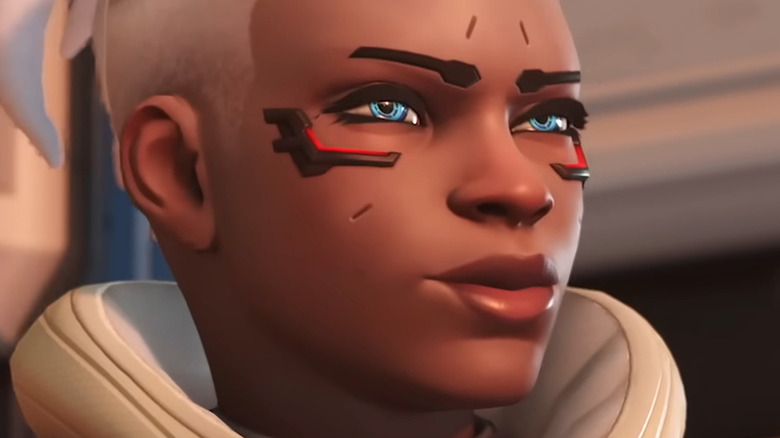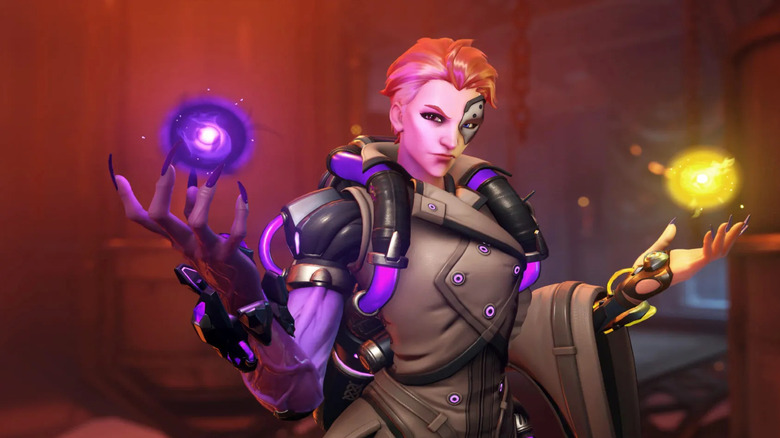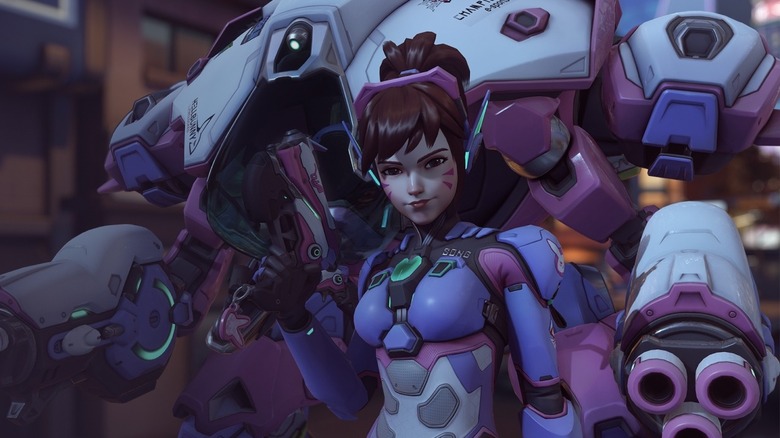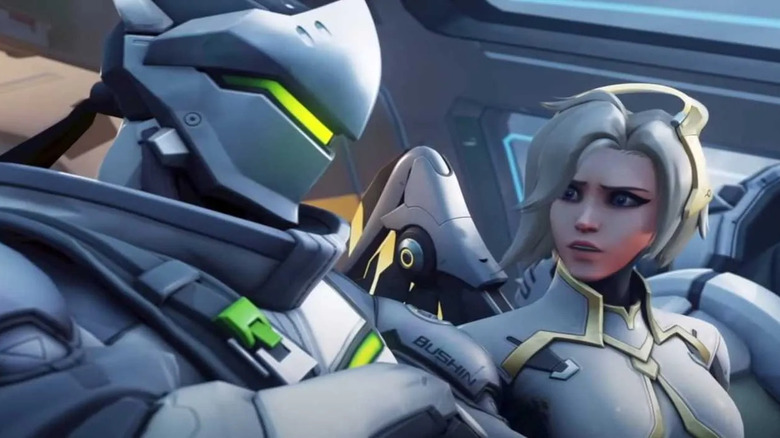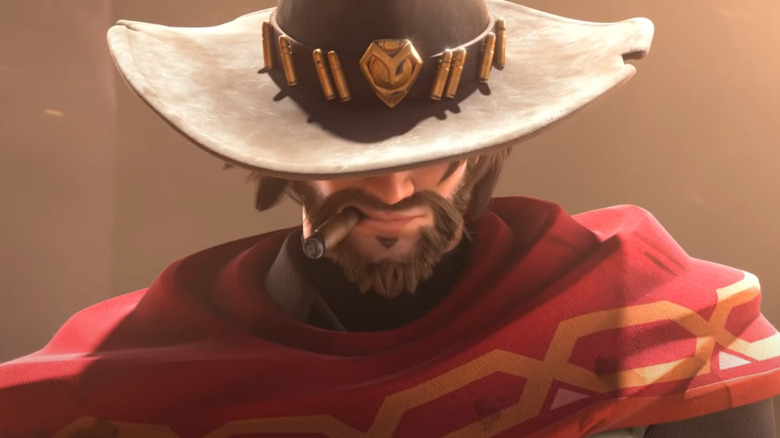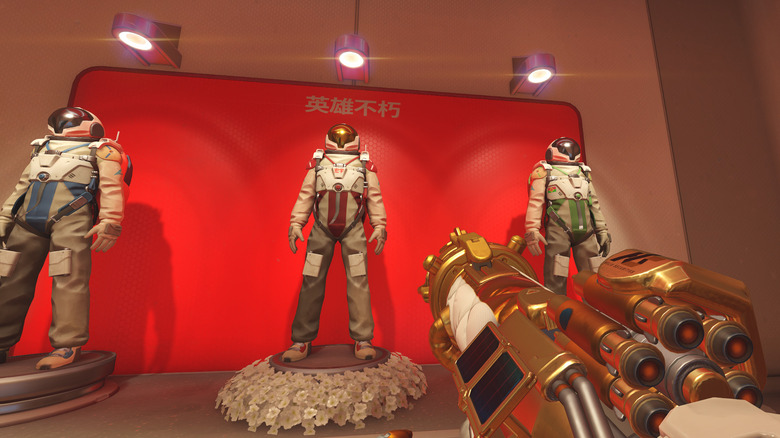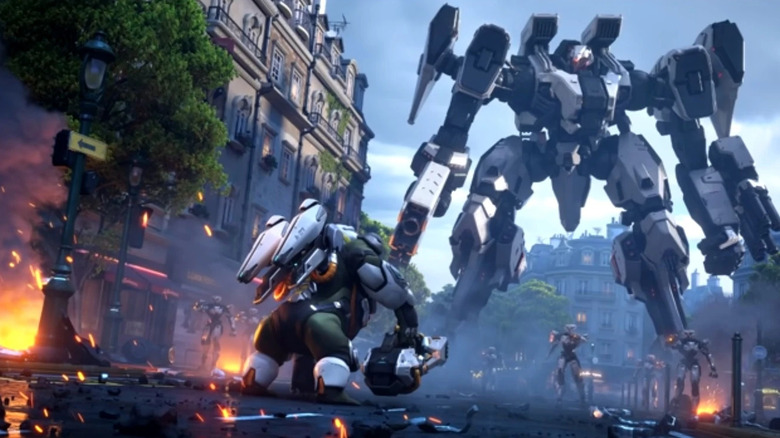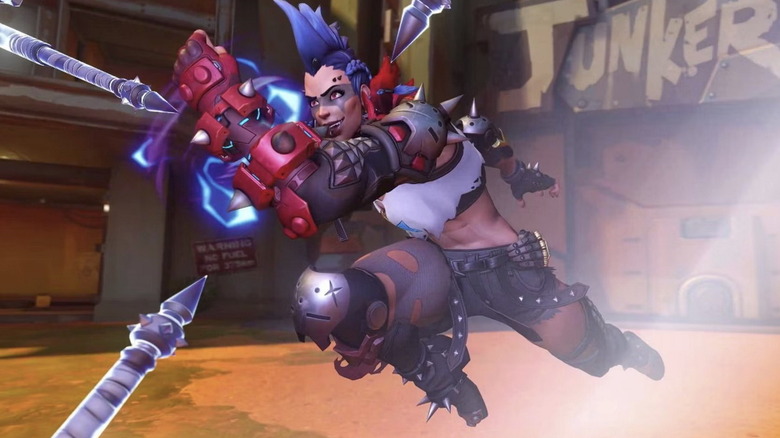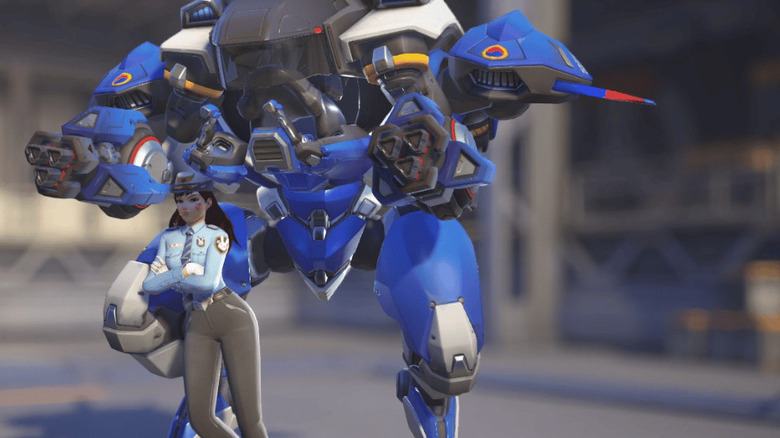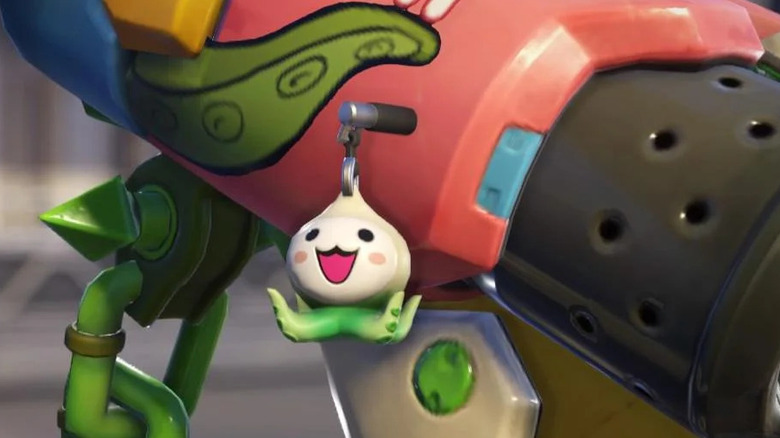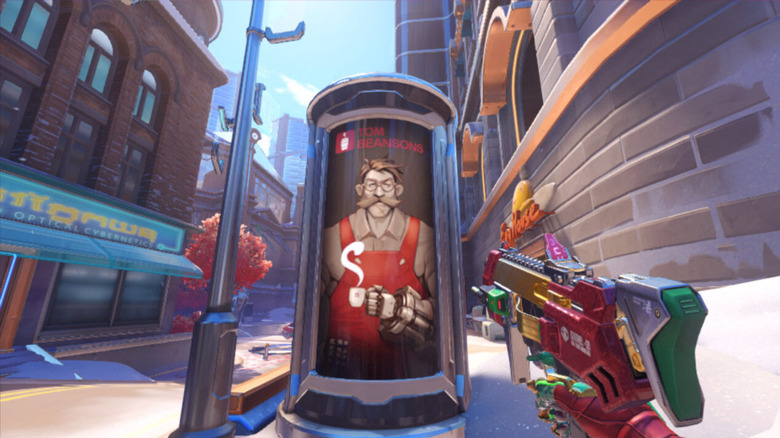Things Only Adults Notice In Overwatch 2
"Overwatch 2" helped revitalize and usher in a new era for the hero shooter franchise, bringing with it sweeping changes from "Overwatch," including numerous character alterations and a drastic move from teams of six players to only five. Along with these new additions and reworks, the sequel also introduced three new heroes to its roster, introduced a new game mode, and delivered a massive amount of brand new content.
In all of that new content, adult players also started finding plenty of details that younger players likely miss. Given how cartoony and family-friendly "Overwatch 2's" graphical style is, this helps give older players something to find to help flesh out the game's world and characters along the way. The "Overwatch" mythology is a gift that keeps on giving. With that in mind, here are some of the dark and interesting details that only adult players may notice in "Overwatch 2."
Moira's dedication to science
Moira is a unique support hero in "Overwatch 2" due to the way in which her healing ability functions. Her primary firing mode is a mist-like healing chemical, while her alternate fire sucks the life from enemies, which is then converted back into the healing chemical. This is a very interesting method of healing, both from a mechanical standpoint and in the sense of the franchise's lore, and it led one fan to try and figure out how it works.
In a post to Reddit, user Aitipse_Amelie detailed their theory of a disturbing detail to Moira's equipment. Upon inspecting the character's skins, they discovered that the tubes connecting the gauntlets she uses for both her alternative and primary fires disappear around her elbows. This seems to imply that those tubes may go through her body to reach the backpack she wears, which in turn handles the conversion of the materials. Other fans have taken this idea further, theorizing that her own heart acts to circulate the chemicals through her body.
This fact becomes even more disturbing when considering that Moira is a prolific scientist who developed the technology she uses in combat. Imagining the drive she must have possessed to undergo the pain of various experiments and tests to imbed these tubes is incredible and upsetting. It also helps to illustrate just how dedicated she is to technological advancement, even at the cost of suffering for herself and others.
Overwatch characters are... popular with adults
Characters are at the core of the player experience in "Overwatch 2." After all, it is a hero shooter. Each character boasts their own unique play style and kit for players to take advantage of during matches and learn throughout their play time. These facts foster a lot of connections between players and their favorite characters, which is further aided by each character's quirks, design, and personality.
However, the characters of "Overwatch" have also achieved a level of popularity that the developers likely didn't intend. The first game's popularity on adult websites was so ubiquitous that Kotaku was able to rate all of its characters based on the frequency with which they were searched in 2017. This did not slow down with the arrival of the sequel. In fact, when "Overwatch 2" first released, Kotaku likewise reported that many of its characters rocketed to the top searches on adult entertainment sites. This is quite literally an aspect of the game series that only adults might notice.
Genji and Mercy, sitting in a tree
The popularity of the characters in "Overwatch" has also fostered numerous ships that the game's player base supports. For those who don't know, a "ship" is when fans of a property or franchise believe that two or more characters in a property either are or should be in a relationship together.
One of the most popular ships in "Overwatch" is one between Genji and Mercy. The ship is founded on the series lore that includes Mercy rebuilding Genji's body after he was defeated in battle by his brother Hanzo. This saved Genji's life and prompted him to start taking his purpose in life more seriously, eventually joining up with Overwatch to try and make the world a better place.
Fast forward to the cinematic reveal trailer for "Overwatch 2" and the developers dropped a hint that the ship may be canonical. This comes early on in the trailer as it shows different private areas of numerous heroes from Overwatch. One of these assumedly belongs to Mercy because of a picture she has of herself with friends in the area. By the picture there is also a keychain hanging from the wall that can be found in a vending machine in the Hanamura map from the original "Overwatch." Hanamura just happens to be the home map of none other than Genji, hinting that it was him that gave it to her.
Cassidy's name change
Cole Cassidy is "Overwatch 2's" resident cowboy sharpshooter. He is a charismatic outlaw who wields a revolver with incredible skill. He plays a bit role in the franchise's lore, but he's also played a small role outside of the game's universe — in a way that younger "Overwatch 2" players likely won't know anything about.
A large part of why there is a good chance they won't know anything about it is because Cassidy went by a different name for the majority of the lifespan of the first "Overwatch." When the game was initially released, he went by the name of Jesse McCree, or just McCree. The change in McCree's name on the heels of a massive controversy at Activision Blizzard, during which allegations ran rampant regarding its toxic work culture.
McCree had his name changed to Cassidy as the studio attempted to distance the game from the ongoing scandals. The name "Jesse McCree" was originally given to the character in reference to a game developer, who was fired for his apparent role in fostering the aforementioned toxic work environment. The character's name change has an entirely different reasoning in-universe, of course, but older players will likely be all too aware of the true cause for Cassidy's new lease on life.
A real hero
This bit of set dressing is actually a holdover from the first "Overwatch," but it's a detail many players still do not catch, especially younger ones. To pay tribute to an "Overwatch" fan who passed away, the developers made a modification to a section of the Lijiang Tower map.
Back in May 2016, "Overwatch" fan Wu Hongyu tragically died one day before the game was fully released. Hongyu witnessed an attempted robbery of one of his college classmates in China. He attempted to stop the robbery and was killed in the process. To commemorate Hongyu's bravery, the developers of "Overwatch" modified one of three astronaut suits that were part of a memorial on the map. The suit in the center was given a ring of flowers beneath it and Hongyu's name on its chest. Above the suit, the game's iconic phrase pf "heroes never die" can be seen.
If there were any doubts surrounding this statue's purpose, a Blizzard spokesperson explained to Polygon in 2016, "We added that in remembrance of a brave member of our community."
Origins of the Omnics
Omnics are a sentient race of artificial life that were manufactured by a corporation in an attempt to lower the costs of production and increase profit margins. In short, the living, thinking Omnics were created as a form of futuristic slave labor. Eventually, the company that built the Omnics was shut down, and it also deactivated all of its Omnics — leaving their minds in limbo as they sat dormant. People were then surprised when the Omnics suddenly returned to life, spurred on by an intense aggression toward all of humanity. This sparked a war that became known as the Omnic Crisis. The war occupied the entire world as the Omnics destroyed numerous cities and killed countless of innocents.
The Omnic Crisis is most often used in "Overwatch" to shine a negative light on the Omnics and to show why Overwatch is needed. However, adults paying attention to the lore and story of "Overwatch" will notice that the morality of the Omnics isn't so cut and dried.
The Omnics were used as slaves, then tossed aside when the world no longer had a "use" for them. It makes sense that they'd want some kind of revenge, and the very core of the Crisis is that the Omnics simply want a home of their own. Their methods may be violent, but their motives are much more nuanced than simple evil for the sake of it.
Junker Queen's kneepad
One of the three new heroes that came with the launch of "Overwatch 2" was the tank hero Junker Queen. As her name implies, Junker Queen is the ruler of a sub faction in the "Overwatch" universe that includes the characters Junkrat and Roadhog known as the Junkers. The Junkers are visually defined by their propensity for taking random pieces of gear and even trash to build their own equipment. Junker Queen's weapons don't have the same piecemeal design of Junkrat or Roadhog, but the gear that makes up her appearance does.
One element of this is a metal kneepad. However, it did not take fans long to realize just how much the kneepad resembles the facial appearance of the Omnics, a race of sentient robots that play a massive role in the "Overwatch" story. The Omnics are represented in the game by the likes of Zenyatta and Orisa.
Junker Queen using an Omnic's faceplate as a kneepad makes sense, as the Junkers harbor a lot of hate for the Omnics. The kneepad is an effective and subtle nod toward the tensions between the two groups that younger players will likely miss. And it's probably a good idea to keep this one on the subtle side, as wearing a sentient creature's actual face as a piece of gear is extremely morbid.
D.Va is attracted to robots
When players are sitting in their team's spawn room at the start of matches, their chosen heroes may begin to have short conversations with one another. This is a wonderful feature that helps flesh out the game's story and characters, and it's usually good for a chuckle during long loading times. Sometimes, however, players can glean some interesting information that they wouldn't have expected.
One of these comes from an exchange between Ashe and D.Va, which seemingly established that D.Va is attracted to robots. The discussion starts with D.Va commenting to Ashe that there was a cute boy with her on one of her wanted posters. At first, Ashe thinks that D.Va is talking about Cassidy, but D.Va then clarifies that she was referencing Ashe's giant Omnic companion, Bob.
Omnics are a sentient species, but this exchange does bring up the question of interspecies relationships between them and humans, a topic which "Overwatch 2" otherwise avoids. The dialogue also brings up questions regarding D.Va's relationship with the mech that she fights in. Her mech isn't an Omnic, but the game seems uninterested in drawing any further lines in this regard.
Overwatch cosmetic prices in the real world vs. the game
While younger players may not think about it while jumping into the free-to-play "Overwatch 2," adults will likely realize how shady the game's monetization practices can be. The move to being a freemium game arrived with the introduction of new seasonal battle passes, a rotating store of cosmetics, and more customization options like weapon charms and name plates. This is all par for the course, but some players have pointed out that the in-game cosmetics sometimes sport ridiculous price tags.
One prime example of this is an in-game weapon charm that resembles the Pachimari character introduced in the first game. For years now, players have been able to purchase a physical keychain of Pachimari from Blizzard's online store. This led to one player pointing out on Reddit that they were able to purchase the real-world charm for less than its digital counterpart costs in "Overwatch 2." The difference is only around a couple dollars, but it is still a striking thing to realize.
Pop culture apparently stopped years ago
Both "Overwatch" games are filled with easter eggs and fun nods to other games, movies, and pieces of pop culture. Whether in voice lines, skins, or small environmental details, it is obvious that the developers have had a fun time pouring references to their favorite properties into this work. These are always fun for the community to track down and discuss, and they help to ground the game in the future of our reality.
However, some adults may realize that the game's myriad references seem to point toward the game's setting not developing new pop culture at the rate one would expect. Of course, there are elements of the cultures and popular media unique to "Overwatch" sprinkled throughout it, such as Lucio's music. However, a majority of the references that the characters make are tied to real world pop culture that exists currently, with characters nodding to everything from "Star Wars" to "Pirates of the Carribean."
"Overwatch 2" is set in the year 2033, meaning that in the franchise's world, there was apparently an entire decade in which very little popular media left any impact on people. Maybe that's what happens when there's a war with killer machines.

